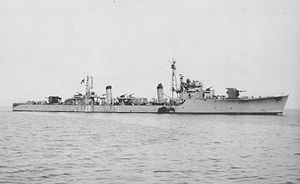Japanese destroyer Sugi (1944)
 Sister ship Momi, 4 September 1944
| |
| History | |
|---|---|
| Name | Sugi |
| Namesake | Cedar |
| Builder | Fujinagata Shipyards, Osaka |
| Laid down | 25 February 1944 |
| Launched | 3 July 1944 |
| Completed | 25 August 1944 |
| Fate | Transferred to the Republic of China Navy, 31 July 1947 |
Republic of China | |
| Name | ROCS Hui Yang |
| Acquired | 31 July 1947 |
| Stricken | 11 November 1954 |
| Fate | Scrapped, after 11 November 1954 |
| General characteristics (as built) | |
| Class and type | Matsu-class escort destroyer |
| Displacement | 1,282 t (1,262 long tons) (standard) |
| Length | 100 m (328 ft 1 in) ( o/a ) |
| Beam | 9.35 m (30 ft 8 in) |
| Draft | 3.3 m (10 ft 10 in) |
| Installed power | 2 × kW ) |
| Propulsion | 2 shafts, 2 × geared steam turbines |
| Speed | 27.8 knots (51.5 km/h; 32.0 mph) |
| Range | 4,680 nmi (8,670 km; 5,390 mi) at 16 knots (30 km/h; 18 mph) |
| Complement | 210 |
| Sensors and processing systems |
|
| Armament |
|
Sugi (杉, "Cedar") was one of 18 Matsu-class escort destroyers built for the Imperial Japanese Navy (IJN) during World War II. Completed in mid-1944, the ship played a minor role in the Battle off Cape Engaño in October, escorting aircraft carriers and then began escorting convoys. She was damaged during the Battle of Ormoc Bay in December escorting a troop convoy in the Philippines and then escorted cruisers on a bombardment mission during Operation Rei later that month. Sugi was damaged again by American aircraft during the South China Sea raid in January 1945 and then escorted a convoy back to Japan in February where she was repaired.
Inactive for the rest of the war, she was surrendered to the
Design and description
Designed for ease of production, the Matsu class was smaller, slower and more lightly armed than previous destroyers as the IJN intended them for second-line duties like escorting convoys, releasing the larger ships for missions with the fleet.
The main armament of the Matsu-class ships consisted of three
Construction and career
Authorized in the late 1942

The ship was damaged by aircraft from Task Force 38 at
The destroyer was disarmed and used to repatriate Japanese personnel in 1945–1947. Sugi was turned over to the
Notes
Bibliography
- Dodson, Aidan & Cant, Serena (2020). Spoils of War: The Fate of Enemy Fleets after Two World Wars. Barnsley, UK: Seaforth Publishing. ISBN 978-1-5267-4198-1.
- Jentschura, Hansgeorg; Jung, Dieter & Mickel, Peter (1977). Warships of the Imperial Japanese Navy, 1869–1945. Annapolis, Maryland: United States Naval Institute. ISBN 0-87021-893-X.
- Nevitt, Allyn D. (1998). "IJN Sugi: Tabular Record of Movement". www.combinedfleet.com. Retrieved 21 September 2020.
- ISBN 1-59114-119-2.
- Stille, Mark (2013). Imperial Japanese Navy Destroyers 1919–45 (2): Asahio to Tachibana Classes. Botley, UK: Osprey Publishing. ISBN 978-1-84908-987-6.
- Sturton, Ian (1980). "Japan". In Chesneau, Roger (ed.). Conway's All the World's Fighting Ships 1922–1946. Greenwich, UK: Conway Maritime Press. ISBN 0-85177-146-7.
- ISBN 0-87021-326-1.
